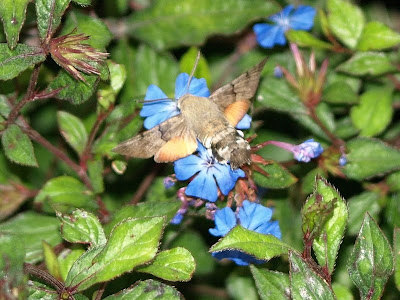 Andy Field took these two photos recently of a hummingbird hawkmoth that he saw sipping nectar from flowers in his garden in High Street North in West Mersea. Considering these moths are always on the move, these photos clearly show the markings of the body and orange hindwings well. The one I saw in my garden last week was buzzing from flower-spike to flower-spike so quickly, that even holding a camera in my hand at the time, it was pointless attempting to get the moth in any sort of shot.
Andy Field took these two photos recently of a hummingbird hawkmoth that he saw sipping nectar from flowers in his garden in High Street North in West Mersea. Considering these moths are always on the move, these photos clearly show the markings of the body and orange hindwings well. The one I saw in my garden last week was buzzing from flower-spike to flower-spike so quickly, that even holding a camera in my hand at the time, it was pointless attempting to get the moth in any sort of shot. After a poor showing over the last two summers, there seem to be a few more reports this year from elsewhere in the county. Perhaps the warm summer has helped bring a few more into the country from the continent.
After a poor showing over the last two summers, there seem to be a few more reports this year from elsewhere in the county. Perhaps the warm summer has helped bring a few more into the country from the continent. A moth trapping session at the country park late on Wednesday 28th was dominated by lots of these silver-Y moths, one pictured above. As a small group of us gathered to see what moths would be flying, many of these medium sized brown moths apeared out of the darkness and fluttered around the light. Many of them settled down on the nearest object they found, either the trap or the grass, as well as many resting on ourselves. By dawn 80 were in the trap, with at least a further 20 on the nearby ground. It has been a few summers since there have been such large numbers here, many of these ones being recent immigrants.
A moth trapping session at the country park late on Wednesday 28th was dominated by lots of these silver-Y moths, one pictured above. As a small group of us gathered to see what moths would be flying, many of these medium sized brown moths apeared out of the darkness and fluttered around the light. Many of them settled down on the nearest object they found, either the trap or the grass, as well as many resting on ourselves. By dawn 80 were in the trap, with at least a further 20 on the nearby ground. It has been a few summers since there have been such large numbers here, many of these ones being recent immigrants. The iron prominent pictured above, was another visitor to the trap, about the third record this summer. Close-up the wings show the subtle iron-red markings. The larvae feed on the leaves of trees such as birch and alder.
The iron prominent pictured above, was another visitor to the trap, about the third record this summer. Close-up the wings show the subtle iron-red markings. The larvae feed on the leaves of trees such as birch and alder.Most of the main moth activity occurred in the first half of the night and as the sky cleared later on, there were less new arrivals in the trap by early morning at 4.30. About 35 species of macros were noted including 3 poplar hawkmoth, drinker, maple prominent, yellow-tail, oak hook-tip, magpie, flounced rustic, grey dagger, broad-bordered yellow underwing, bordered sallow and dun-bar.
Also joining in the big moth gathering were several pipistrelle bats hawking over the trap as the silver-Ys came in. Earlier in the evening a fox and 3 badgers were seen as night fell near the park pond.
In the morning 5 willow warblers were noted in various corners of the park, either feeding with tit flocks, heard calling or heard singing a loud sub-song. Two birds singing from the willows at the pond made the place sound more like a springtime scene than high summer. It seems 2 or 3 weeks early to have the willow warblers passing through in these numbers.
Some of the usual warblers still possibly resident, were seen including blackcaps, whitethroats, lesser whitethroats and chiffchaff. At least one nightingale was heard calling from its usual area of bushes, so they've not gone back to Africa just yet.
At the park pond the 5 tufted ducklings were still present while on the pools in the fields, 8 lapwing and 2 black-tailed godwits were the only waders of note here. A mallard watched over her brood of 5 ducklings.

The warm weather brought a selection of butterflies out such as this comma on a bramble flower. Others on the wing included red admiral peacock, common blue, small copper, large white, small white, green-veined white, speckled wood, meadow brown, hedge brown, Essex skipper, large skipper.
Amongst the dragonflies were one or two small red-eyed damselflies, brown hawker, ruddy darter, common darter, migrant hawker and southern hawker.
One adder was tucked into the base of a bramble bush in the usual spot for them near the car park. A couple of sloughed skins have been seen at the park in the last few days.
A hobby flashed over the East Mersea road at the bus turning circle on Tuesday scattering a flock of 40 swallows resting on the wires. The hobby made an unsuccessful attempt at snatching one, as the flock of swallows dispersed.
Martin Cock had a willow warber in his West Mersea garden and a Mediterranean gull over Waldegraves.
















































